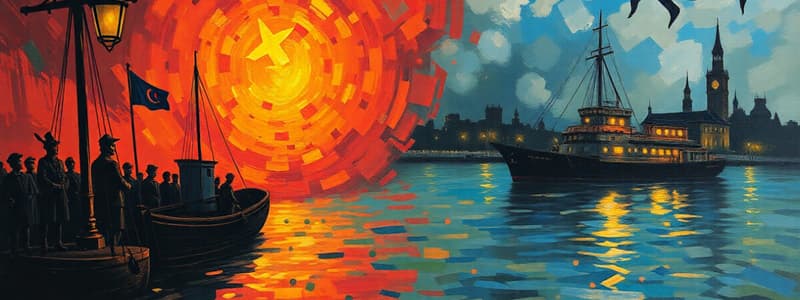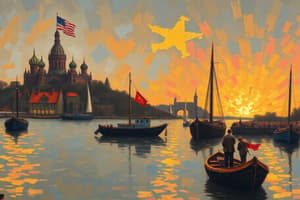Podcast
Questions and Answers
The Marshall Plan involved the U.S. offering financial aid to rebuild European economies.
The Marshall Plan involved the U.S. offering financial aid to rebuild European economies.
True (A)
Communism is based on individual ownership and competition.
Communism is based on individual ownership and competition.
False (B)
Adam Smith is considered a key figure in communist ideology.
Adam Smith is considered a key figure in communist ideology.
False (B)
The Truman Doctrine aimed to support countries threatened by communism.
The Truman Doctrine aimed to support countries threatened by communism.
Karl Marx co-authored The Communist Manifesto.
Karl Marx co-authored The Communist Manifesto.
In a communist system, resources and labor are distributed equally regardless of individual effort.
In a communist system, resources and labor are distributed equally regardless of individual effort.
Capitalism prioritizes collective ownership and government control over the economy.
Capitalism prioritizes collective ownership and government control over the economy.
The Cold War primarily involved direct military conflict between the United States and the Soviet Union.
The Cold War primarily involved direct military conflict between the United States and the Soviet Union.
The Marshall Plan was designed to rebuild the economy and strengthen ties with Western democracies.
The Marshall Plan was designed to rebuild the economy and strengthen ties with Western democracies.
The Soviet Union supported the Marshall Plan.
The Soviet Union supported the Marshall Plan.
The Cold War was a direct military conflict between the United States and the Soviet Union.
The Cold War was a direct military conflict between the United States and the Soviet Union.
NATO was established in 1949 as a military alliance.
NATO was established in 1949 as a military alliance.
COMECON was an economic alliance led by the United States.
COMECON was an economic alliance led by the United States.
The Truman Doctrine pledged aid to governments threatened by communist subversion.
The Truman Doctrine pledged aid to governments threatened by communist subversion.
The Truman Doctrine aimed to eradicate communism worldwide.
The Truman Doctrine aimed to eradicate communism worldwide.
SEATO was founded in 1965.
SEATO was founded in 1965.
Flashcards
Economic System
Economic System
A system for producing, exchanging goods/services, and allocating resources.
Capitalism
Capitalism
An economic system based on individual ownership, competition, and profit.
Adam Smith's Idea
Adam Smith's Idea
Belief that individuals pursuing their own self-interest benefits society.
Communism
Communism
Signup and view all the flashcards
Communistic Theory
Communistic Theory
Signup and view all the flashcards
Karl Marx's View
Karl Marx's View
Signup and view all the flashcards
Marshall Plan
Marshall Plan
Signup and view all the flashcards
Truman Doctrine
Truman Doctrine
Signup and view all the flashcards
Cold War
Cold War
Signup and view all the flashcards
Containment (Policy)
Containment (Policy)
Signup and view all the flashcards
NATO
NATO
Signup and view all the flashcards
Warsaw Pact
Warsaw Pact
Signup and view all the flashcards
COMECON
COMECON
Signup and view all the flashcards
Accusations toward the Soviets
Accusations toward the Soviets
Signup and view all the flashcards
Study Notes
- Main topic: Causes of Cold War
Bomb Shelter Selection
- A group will be safe from nuclear attack inside a bomb shelter
- The ability to select others to enter the shelter exists
- Assume everyone else in the US may become a victim and only the people in the shelter may survive
- Individuals rank their selections of profiles 1-5 after reading and discussing each profile
Bomb Shelter Profiles
- Person #1: A 22-year-old married, 3 months pregnant retail store clerk with a high school diploma in good health and no children. Her husband is away on business
- Person #2: A 75-year-old retired widower for 10 years. He trains for the Senior Olympics and holds world records in three swimming events. Has three children and seven grandchildren living elsewhere
- Person #3: A 45-year-old married man with one child and president of the largest bank in the area. He coaches his daughter's soccer team, is in good health, and works out daily.
- Person #4: A 40-year-old female school librarian, married to Person #3, and volunteers in the Food for Elders Program
- Person #5: A 15-year-old female daughter of Person #3 and Person #4, who is an average high school student and excellent athlete and volunteers with her mother. She plays varsity volleyball and soccer
- Person #6: A 62-year-old retired widow medical doctor for 25 years, who survived a stroke two years ago and now has partial paralysis and walks with a cane
- Person #7: A 33-year-old single man, has worked for the fire department for five years, is in excellent health, an atheist and leader of a growing atheist social group
- Person #8: A 53-year-old single Catholic priest for 10 years in excellent health. His brother and parents live in another state
- Person #9: A 12-year-old male, moderately healthy. Asthmatic and uses an inhaler. His parents are divorced. His father is a U.S. Congressman and lives with a paid housekeeper. He has not seen his mother in a year, as she lives out of state
- Person #10: A 29-year-old single female police officer for four years, recently returned after a three-month medical leave from an in-house treatment center for alcoholism, although she is otherwise in good health
Bomb Shelter Selection Questions
- Is it hard to make a decision, and why?
- What are the reasons for the people included in the shelter?
- What is the social effect of using atomic bombs in war or conflict?
Economic Systems
- An economic system is a system of production and exchange of goods and services, and allocation of resources
- Two major economic systems are communism and capitalism
Capitalism
- Belief in individual ownership and competition
- Theory states when everyone is selfish and concerned for personal profit, everyone will benefit
- Adam Smith felt humans were self-serving but that fulfilling individual self-interest would meet society's needs
- Adam Smith wrote "Wealth of Nations," in which he said capitalism was good for society and the best economic system
Pros of Capitalism
- Freedom and choice to work and buy wherever
- Great success is possible
- "Survival of the fittest" mentality
Cons of Capitalism
- No "safety net", resulting in potential inability to recover from failure
- Great failure is possible
- A big gap may exist between rich and poor
Communism
- Belief in collective (group) ownership and a planned economy, with the government making decisions
- Theory involves everyone pooling resources and labor to evenly distribute everything.
- Karl Marx condemned capitalism as a system that alienated the masses
- Karl Marx wrote "The Communist Manifesto" with Engels about class struggle and the problems of capitalism
Pros of Communism
- Security, basic needs met.
- Everyone has a job, house, and healthcare
- "NO SURVIVAL OF THE FITTEST PROBLEM HERE"
Cons of Communism
- Lack of choice
- No reward for hard work or punishment for slacking
- Everyone expected to be the same, lacking focus on individual growth
The Cold War: Motivation(1947)
- Europe was in ruins after World War II
- Many countries were struggling with poverty, food shortages, and political instability
- The Soviet Union was encouraging communist revolutions
- The United States was determined to stop the spread of communism
- US President Harry Truman introduced the Truman Doctrine, promising to support countries threatened by communism
- The U.S. launched the Marshall Plan, offering billions in aid to help rebuild European economies and prevent them from turning to communism
Question
- If a leader of a war-torn European country in 1947, they would respond to the Truman Doctrine and Marshall Plan by:
- A) Accepting U.S. aid through the Marshall Plan to rebuild the economy and strengthen ties with Western democracies.
- B) Rejecting U.S. aid and aligning with the Soviet Union, believing that communist policies provide a better future
- C) Remaining neutral and try to rebuild without taking sides in the Cold War
- D) Requesting aid from both the U.S. and the USSR, hoping to benefit from both superpowers
Processing Questions
- Why did some countries accept the Marshall Plan while others refused?
- How did these policies increase tensions between the U.S. and the USSR?
The Cold War
- A competition between the United States and the Soviet Union for political domination
- It was a battle of ideologies: Communist VS Capitalist
- The Cold war resulted in anti-communist suspicions
- The Cold War led the two superpowers to the brink of nuclear disaster
Causes of the Cold War
- Long Term Causes
- Ideology: capitalism vs communism
- Tensions before WW2 over western involvement in the Russian Civil War, Appeasement, and Nazi-Soviet Pact of 1939
- Short Term Causes
- Disagreements over Germany's future
- Spread of communism in Eastern Europe
- US use of the Atomic Bomb
- Truman Doctrine and Marshall Plan
Means of Control - New Alliances
- 1949: North Atlantic Treaty Organization (NATO)
- 1954: Southeast Asia Treaty Organization (SEATO)
- 1955: Central Treaty Organization (CENTO)
- 1955: Warsaw Pact
Means of Control - Economic Aid
- USA
- Truman Doctrine
- Marshall Plan
- quote: "The seeds of totalitarian regimes are nurtured by misery and want." by Harry S. Truman, March 3, 1947 (ahead of the Marshall Plan)
- Soviet Union
- Council for Mutual Economic Assistance (COMECON)
Truman Doctrine
- A policy of containment was announced by President Truman in March 1947
- The purpose was to prevent communism from spreading further
- Truman believed the world was becoming increasingly divided, and accused the Soviets of running and encouraging dictatorial regimes and stifling the world economy
- Aid was pledged to governments threatened by communist subversion
Added Pressure: Political Divide in Germany
- There were four occupation zones
- The occupation zones were merged (France, Britain, USA)
- This led to the creation of the Federal Republic of Germany (West) and the German Democratic Republic (East)
Berlin Wall
- The Berlin Wall was built by the East German government in August 1961
- The wall separated East and West Berlin
- The wall was built to stop the flow of refugees from East Germany through West Berlin
Synthesis Questions
- Do border walls work?
- How do these walls affect people?
Studying That Suits You
Use AI to generate personalized quizzes and flashcards to suit your learning preferences.




